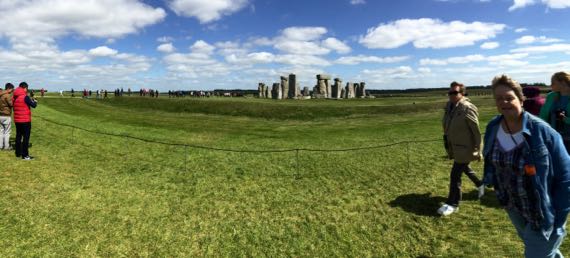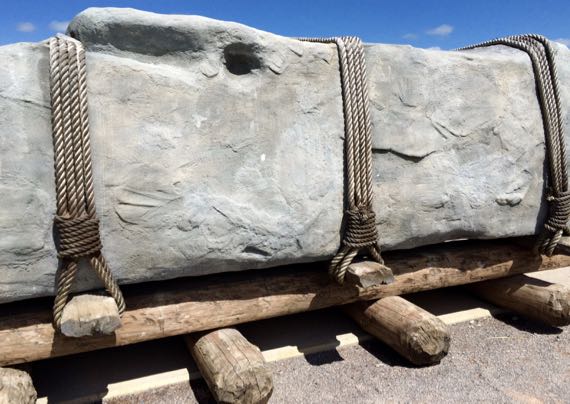
English Heritage (we’re among its newest members) has reorganized access to Stonehenge. One reason this was sorely needed is that the cruise ships dock at Southampton, and passengers are bused to Stonehenge, about an hour each way. So the normal flux of tourists is augmented by rafts of these strange birds….
There’s now a fantastic visitor centre and bus transfer setup to move visitors from a safe distance away for parking and congesting to hobbling distance from the stones. This centre opened in December 2013 (not present on Google satellite view last time I checked), such a change from our 1989 visit. They’ve also channeled foot traffic to a track around the stones that keeps people away from them, yet allows us to see all sides. There’s even a little bridge across the Avenue where it comes into the henge, to better preserve that important feature (postulated to be the main access route). Compare this to the imperiled preservation situation in 1877….
These things do change….

Next to the visitor centre is this display of a life-size model of one of the monster stones that folks moved for many miles to make the stone circles, along with a postulated roller-method for moving the stones along the ground surface. I guess that this is a model explains the solar panel in the top (not shown; yes! seriously!).
I especially liked the room-in-the-round display in the exhibition hall that showed the stone circle viewed from the center, with the sun and stars changing through the annual cycle. I also really liked talking to the archaeologists and having the opportunity to hold real artifacts from Stonehenge, and even a reconstructed Neolithic pot (pieces of a base and some side-wall, all glued together). Loved it!
This ritual landscape is complex and was added to and altered over time. Researchers are still finding new components. Here’s some idea of what’s been recorded. All those green dots are barrows—where someone was buried. This ritual landscape extends north beyond Avebury. Stonehenge and Avebury are over 20 miles apart, as the crow flies.
By the miracle of the internal combustion engine (and I don’t know what other energy sources), we shifted our geographic point of view to the former Londinium. Kinda hard to avoid the Thames and even the Eye.

We sat and watched the water traffic and talked about how much wider the Thames is than the Seine in Paris, or, ahem, the Tiber in Rome. A real contrast. Of course, the Thames is tidal at London, and the others are not.
17 May 2015 at 8:56 am
martha rees says:
You know, in Akumal I saw the guys at the dive shop move a boat from the water back to across the road before a storm. They used logs and rolled it.
17 May 2015 at 10:57 am
Sammy says:
Yeah, I think that’s how they moved the stones on land; there’s still debate on how they moved them across open water….
17 May 2015 at 12:51 pm
James says:
Thanks for posting this. We’re really enjoying it.
So how’s the food? Drink? British hospitality?
How was Foyle-land? Recognize anything?